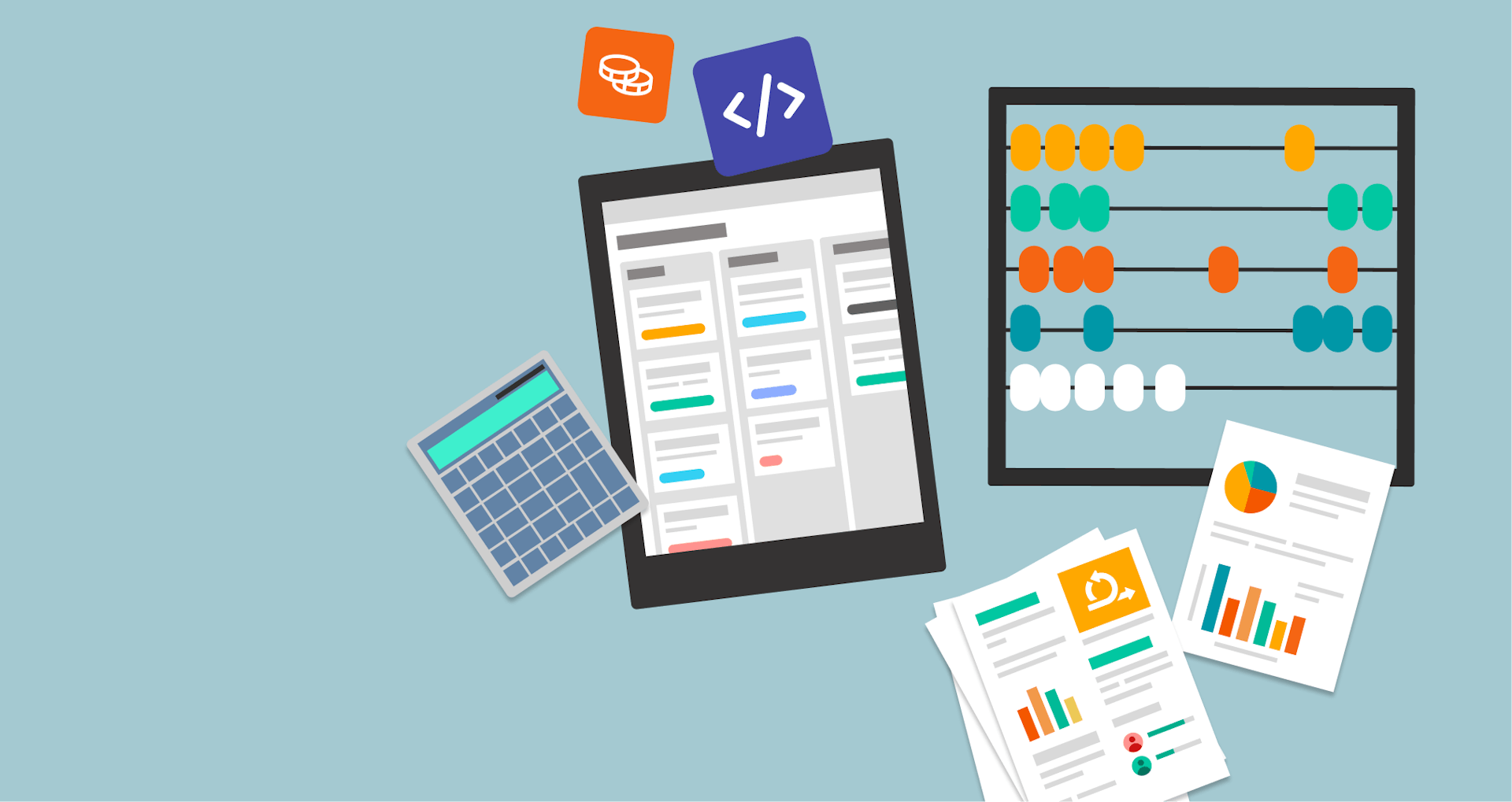Software Development Costs: Everything You Need To Know Before Starting A Project

If you're dreaming about launching the next big app or streamlining your business with custom software, you might be wondering, "How much is this going to set me back?". Don't worry – you’re at the right place!
In this guide, we discuss everything you need to know about software development costs. By the time you finish reading, you'll have a clear understanding of:
- The factors that influence software development costs
- A software development cost breakdown
- Hidden costs to look out for
- Ways to optimise costs in software development projects without sacrificing quality
What Is the Cost of Software Development?
So, how much does custom software development cost? This is probably not what you want to hear, but we’ll say it anyway: it depends!
It’s a bit like building a house. The total cost depends on the scope. Are you envisioning a compact two-bedroom cottage or a sprawling estate with a hot tub and a home theatre?
The size of the house, the quality of materials, the complexity of the design – all these decisions influence the final price. Then there's who the builder is. Have they built this kind of house before? Are they using experienced architects, contractors, and subcontractors?
Developing software works in much the same way.
Because every software project is unique – much like every dream home – the cost can only be accurately estimated once you have detailed specifications.
However, to help you get a general idea, here are some ballpark figures:

These figures are very approximate and can hugely vary depending on the project's complexity. Below, we discuss the factors contributing to software development costs in more detail.
Key Factors Influencing Overall Software Development Cost
Project Complexity and Scope
Two of the main drivers of cost are the size and complexity of the project, which include the number of features you want and how complicated they are to build.
More features mean more time and effort to build, so the cost goes up. A good way to keep costs under control is to focus on the most important features first, leaving the rest for later.
Start with a minimum viable product (MVP). This means including only the features that are absolutely necessary and adding more as you go. Let’s illustrate this with an example.
Imagine that you’re building a new mobile app for a restaurant to help customers order food for pickup and delivery. Here’s how the scope and complexity of the features you need would come into play:
Initially, you might want to include features like:
- A menu with images and prices
- The ability to order online
- Payment options (credit card, PayPal, etc.)
- A loyalty program with rewards points
- Customer reviews and ratings
However, each additional feature takes time and effort to develop. The cost will be much higher if you include everything from the start.
Instead, you could prioritise the essential features, such as:
- A menu with images and prices
- Online ordering and payment
Sometimes, we get caught up in adding too many bells and whistles. Simplifying features that meet your users' needs can help cut costs and speed up the development of your software product.
Feature Complexity
It’s also important to consider that some features are more complicated and costly to develop. For example, adding a basic login feature is easier (and cheaper) than building advanced technologies like an AI-powered chatbot.
Technology Stack
A technology stack refers to the programming languages, frameworks, and tools used to build software. Your choices here can reduce software development costs.
Reusing existing code libraries and frameworks can reduce development time and lower costs. On the other hand, if custom-built components or specialised tools are needed, the extra development effort can increase costs.
Also, some technologies (like AI or blockchain) require more specialised skills, which can make the project more expensive because software developers with real experience in these skills are in demand and cost more.
Integration Requirements
Today, most applications don’t work in isolation. They are often connected to external systems, APIs (application programming interfaces), and databases.
For example, in our food delivery app, the payment feature would require using a third-party API. These costs would also need to be factored into the software development cost estimation.
If you have legacy systems, you’ll also need to factor in the cost of migrating this data. Moving data from an old system to a new one can be tricky. The more complex the data, the more time (and money) it’ll take.
Design and User Experience (UX)
Another significant component of software development costs is the app’s UI/UX design complexity.
UI/UX design isn’t just about how the app looks – it’s also about how easy and enjoyable it is for users to interact with.
This includes everything from graphic elements (like buttons, fonts, icons, and colours) to how efficiently users can perform tasks within the app.
When it comes to UI/UX design, three main components influence software development costs:
1️⃣ Complexity of User Interface (UI) Design
A detailed UI design requires more time to create and implement, involving custom graphics, animations, and interactive elements. These details not only enhance the app's look and feel, but also add to development time and cost.
2️⃣ User Experience (UX) Complexity
UX isn’t just about visual impressions – it’s about ensuring users can achieve their goals easily and intuitively.
To ensure a seamless user experience, the process typically involves several key steps, including:
- Creating detailed user personas
- Mapping user journeys
- Designing wireframes and prototypes
- Conducting in-depth research and testing
- Making iterative improvements based on user feedback
The more interactive and tailored the app is to specific user needs, the more resources it will take to design and refine.
This process can significantly increase software development costs, as it requires ongoing testing and improvements to ensure a seamless experience.
3️⃣ Responsiveness and Adaptability
Designing an app or platform to be responsive and adaptable across multiple platforms – smartphones, tablets, desktops – requires extra planning and testing. Ensuring the app performs well on different screen sizes adds complexity and, in turn, (surprise!) raises development costs. Accessibility is also a key consideration, so all users have a great experience, and then there’s multi-language… all of these features add cost and complexity.
Cross-Device Compatibility
Also, keep in mind that the more platforms and devices your app supports, the more design adaptations become necessary.
Each additional platform or device type means more time spent testing, adjusting, and improving the user interface, contributing to higher development costs.
Regulatory Compliance
Additional development work is required to ensure compliance if your software needs to meet specific industry regulations, such as those that apply to the financial or healthcare sectors.
This can involve adherence to stringent security measures, data protection protocols, and other legal requirements, which can increase costs.
By understanding and factoring in regulatory compliance early on in the development process, we can avoid costly adjustments down the line.
Collaboration Model
The way you structure your collaboration with an outsourcing partner directly influences the cost of your software development project. Typically, you’ll encounter three options:



Choosing the Right Model
So, how do you decide which model is suitable for you? Here's a quick breakdown of the key considerations:
- Project clarity: If your project requirements are well-defined and unlikely to change, a fixed-price model offers predictability and cost certainty.
- Flexibility: Are you expecting changes or evolving requirements? An hourly rate or dedicated team model provides the adaptability you'll need.
- Budget control: Fixed-price gives you the most control over your budget upfront. Hourly rates and dedicated teams require careful monitoring to stay on track.
- Project duration: A dedicated team fosters consistency and deep collaboration for long-term projects. A shorter software development project may better suit fixed-price or hourly rate models.
Scalability and Performance
Scalability is a critical factor that influences software development's short- and long-term costs.
Scalability is essentially about how well your software can handle growth – whether that means accommodating more users, expanding features, or managing larger volumes of data.
Two approaches will affect software development costs differently. We discuss them in more detail below.
1️⃣ Building for Scalability from the Start
This approach involves building software that is ready to handle future growth from the start. It requires a more complex architecture and advanced infrastructure, which raises the initial cost. However, by investing upfront, you avoid costly system overhauls later.
Future-proofing your software early on ensures it can grow smoothly without major disruptions or redesigns, leading to significant savings over time.
2️⃣ Gradual Scaling
With gradual scaling, you build the system to meet current needs and expand it as the user base or feature set grows. This keeps initial costs low since you only invest in infrastructure when necessary.
While this is ideal for projects with tight budgets, it can result in higher long-term expenses. Frequent upgrades and adjustments add up, and over time, it may cost more than designing for scalability from the start.
Testing and Quality Assurance
Ensuring your software delivers value consistently across various environments requires an investment of time and resources.
So, the type and depth of testing you choose can significantly impact your overall software development costs.
For example, comprehensive testing – which may include performance, security, usability, and cross-platform compatibility checks – demands more time and resources, directly influencing the project's budget.
For example, software that functions across multiple devices and operating systems will have higher testing costs due to the wide array of environments and scenarios that need testing.
Similarly, applications handling sensitive data, such as those used in healthcare or finance, must undergo rigorous security testing. This often requires specialised tools and expertise, driving up project costs.
💡Key point: The timing of your testing also impacts costs. When you test early and often throughout the development process (iterative testing), you can catch problems sooner, making them less expensive to fix.
Waiting until the end of the project to test may result in having to redo a lot of work, which might end up being costly and could even delay the project.
Timeframe for Development
How fast you need your software built can also affect the cost. An accelerated development process may increase the price.
To reduce costs, it's a good idea to set reasonable deadlines. This will keep costs in check and give your team time to deliver high-quality work.
💡Key point: Rushing through the development process can lead to oversights and mistakes, which may end up costing more to fix later.
Experience and Client Involvement
If this is your first time embarking on a software project, a learning curve may affect the project's duration and cost.
Active participation also affects software costs. In our experience, clients who are actively involved in the project and make timely decisions help keep things moving smoothly can reduce costs.
Post-Development Costs
Launching your software isn't the finish line; it's just the beginning. Remember to budget for these ongoing expenses:
Support and Maintenance Costs
Regular maintenance is crucial to keep things running smoothly. Budgeting for ongoing bug fixes, updates to stay current with evolving technologies, and feature enhancements to delight users is essential. Ignoring these can lead to a deteriorating product and frustrated users.
Hosting and Infrastructure
Whether you choose cloud services or onsite servers, there are costs associated with keeping your software accessible and performing optimally.
These costs can scale significantly depending on the size of your project and the number of users you have.

Hidden Costs to Consider in the Software Development Process
When planning a software development project, it's easy to focus on the obvious expenses, such as coding and design.
However, hidden costs can catch you off guard if you're not prepared. Let's explore some of these less apparent factors so you can budget effectively and avoid surprises.
Scope Creep
Scope creep essentially means that a project's requirements expand beyond the original plan. This can happen when new features are added or existing ones are modified during development.
While it's natural to refine your vision as the project progresses, each change can lead to additional work for the software development team. This not only increases costs, but can also extend the project's timeline.
How to Manage Scope Creep
To keep scope creep in check, having a clear and detailed project plan from the outset is crucial. Here are some strategies to reduce custom software development costs:
✔️Prioritise features: Determine which features are essential for the initial release and which can wait. This helps keep the project focused and the budget under control.
✔️Set clear requirements: Work closely with your development team to establish detailed specifications. The clearer the requirements, the less room there is for misunderstandings.
✔️Implement a change control process: Establish a formal process for handling changes. This might include assessing the impact on cost and timeline before approving any modifications.
✔️Regular communication: Maintain open lines of communication with your development team. We discuss this in more detail in the section below.
Communication Overheads
Effective communication is the backbone of any successful project. Misunderstandings or lack of clarity can lead to the development team building features incorrectly or missing critical elements altogether.
Bad communication often results in rework, where developers have to spend additional time fixing or redoing parts of the project, leading to an increased project cost.
To minimise communication overheads, consider the following approaches:
✔️Use collaborative tools for project planning: Platforms like Slack, Microsoft Teams, or Trello facilitate real-time communication and project management. They help keep everyone on the same page and make information easily accessible.
✔️Have regular meetings: Schedule consistent check-ins such as weekly meetings or daily status checks to discuss progress, address concerns, and adjust plans as needed.
✔️Clear documentation: Maintain detailed documentation of requirements, decisions, and changes in the software project. This provides a reference point for the team and reduces the risk of misinterpretation.
✔️Design mockups and prototypes: Visual representations of features can help ensure everyone understands the intended functionality and design.
Legal and Compliance Expenses
Depending on your project's nature and the industry it serves, you may need to comply with specific laws and regulations.
This could include data protection laws like GDPR, accessibility standards, or industry-specific regulations in healthcare or finance.
Ensuring compliance often requires additional development work, such as implementing robust security measures or adjusting features to meet legal standards. It might also involve consulting with legal experts, which can increase costs.
Failing to address these considerations can lead to legal disputes down the line, which are often far more costly than implementing preventive measures.

4 Ways to Reduce Software Development Costs
You're likely aware that software development pricing can be substantial. But the good news is there are ways to keep those costs in check!
Here are some practical ways to reduce software development costs without compromising quality:
During the Planning and Design Phase
- Clearly defined requirements: Begin with a well-defined scope and detailed project requirements. As we mentioned above, ambiguous goals often lead to scope creep and costly rework.
- Prioritise essential features: Concentrate on core functionalities that provide the most value to users. Avoid "nice-to-have" features that inflate the budget and timeline.
- Adopt agile project management: Agile approaches enable flexibility and adaptation, reducing the risk of developing unnecessary features. We would also highly recommend hiring a project manager.
- Thorough prototyping and user testing: Gather user feedback early and regularly to validate assumptions and avoid costly redesigns in the final development stages.
- Explore open-source software solutions: Utilise freely available, community-supported tools and libraries whenever possible to minimise licensing costs.
During Development
- Code reviews and pair programming: Implement regular code reviews and pair programming to identify and resolve issues early on, thus improving overall code quality and reducing the need for expensive fixes.
- Automated testing: Invest in automated testing frameworks to accelerate the testing process, enable early bug detection, and ultimately save time and resources. The initial development cost is higher, but it will come down in the long term.
- Reuse components: Design modular, reusable code to expedite development and eliminate redundant efforts.
Consider Outsourcing
Outsourcing can be an effective way to develop software without compromising on quality. By partnering with experienced development teams, you gain access to specialised expertise, flexible collaboration options, and transparent communication, all while keeping costs manageable.
For example, working with a trusted outsourcing partner like Rocketmakers offers:
🏆Specialised expertise: Tackle unique challenges with a team experienced in delivering solutions across various industries.
🏆Flexible collaboration models: Choose an approach that suits your project’s needs, whether it’s a fixed-price agreement, hourly rates, or a dedicated team.
🏆Transparency and communication: Ongoing communication ensures your project stays on track and aligned with your goals.
🏆Proven track record: Review the results and success stories of companies that have streamlined their development costs by outsourcing.
Final Thoughts: Software Development Costs
As we've explored, the cost of software development isn't a simple calculation. Numerous factors influence the final price tag.
Hopefully, you now better understand why we said "it depends" at the beginning of this article.
However, if you look into the key drivers of cost we identified, you'd be well positioned to make informed decisions and reduce software development costs.
Are you looking to turn your vision into reality without overshooting your budget? Rocketmakers isn’t just another development agency – we're your collaborative partner in building innovative software solutions. Get in touch with us today!



